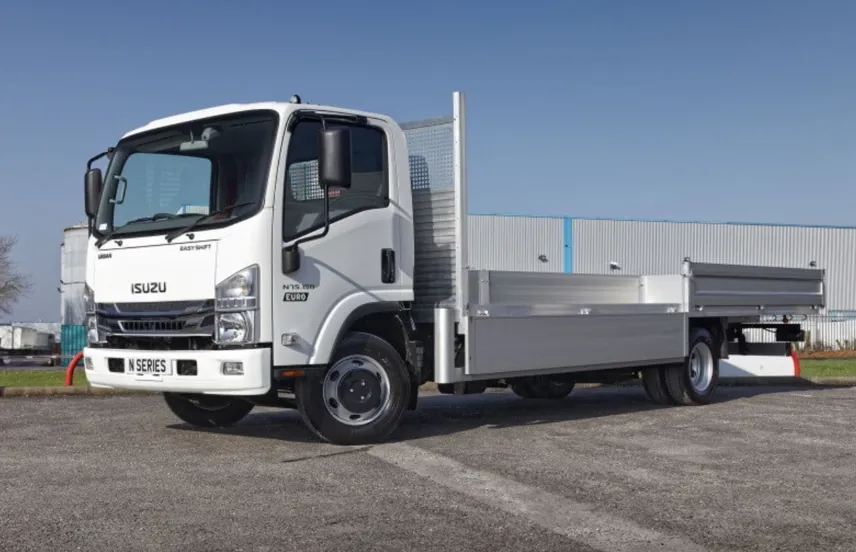Review
The 7.5 tonne urban distribution sector has many players from the market leading Daf LF with a conventional European style cab to the more ‘leaner’ product offerings from Asian based producers such as Fuso and Isuzu Trucks. Both approaches have their different operational strengths and weaknesses with the Asian based products scoring particularly high in low kerbweight/high payload and generally lower chassis and cab height helping with visibility in an urban environment.
The Isuzu ‘Forward’ series, not to be confused the larger and heavier ‘F Series’, is their offering at the lightweight truck segment and is a relatively popular amongst some of the niche sector players. A great example of operations where low kerbweight is a definite advantage are sectors such as vehicle recovery/roadside assistance and chilled/frozen distribution.
Isuzu Trucks essentially has two offerings at this weight with two engines and two power settings at 150bhp and 190bhp, a manual and automated gearbox and a number of conversion offerings. The 150bhp model conversions are based around the popular dropside and tippers sector with the higher horsepower version also including a curtainsider and box body with or without tail-lifts.
In this article we will look at the popular N75.150 which is powered by an Isuzu 3.0-litre four cylinder turbo intercooled diese,l setup to the latest stage ‘E’ Euro emission standard rated at 150bhp (110kW). The torque is 370Nm with a wide band range from 1250rpm to 2800rpm. Further down the driveline is a fluid coupling torque converter type clutch connected to a six speed electro -hydraulically controlled automated gearbox which Isuzu Truck calls ‘Easyshift’ with a 0.708 overdrive gear at the top end.
Obviously the ‘75’ part of the nomenclature denote the 7500kgs gross vehicle weight (GVW) with a standard gross train weight of 8250kgs and an optional 11000kgs. The front axle has a design plated at 3100kgs and the rear is 5800kgs which offers a very credible load latitude of 1400kgs. As mentioned earlier one of the main attributes of the N75 is the low kerbweight which in the case of the day cabbed shortest wheelbase is 2634kgs, split 1654kgs at the front and 980kgs on the rear. Indeed the body and payload ranges from 4866kgs to the longest wheelbase 4812kgs, this equates to around 500-750kgs improved payload compared to the more traditional European manufacturers.
There are four chassis wheelbases starting at 2765mm to 4475mm, which cover recommended body lengths from 4267mm to 6096mm with all wheelbases boasting a 90 litre fuel tank and 16 litre Adblue tank for the SCR system. The reverse Elliott-I beam front axle is attached to the chassis by parabolic steel springs with hydraulic shock absorbers and anti roll bar. The banjo fully floating rear axle is suspended by semi-elliptical steel springs with hydraulic shock absorbers and an antiroll bar.
The braking system starts at the engine with an engine exhaust brake system, and there are standard braking systems such as ABS, electronic brake distribution (EBD), and anti-slip regulation (ASR). A stereo camera system at the front of the vehicle provides data for the lane departure warning systems which alerts the driver via a warning buzzer and LCD monitor. The camera system is also utilised by the advanced emergency braking system which helps to reduce collision damage helping pedestrian safety. As far as the service brakes are concerned they are 310mm ventilated disc brakes on both axles with asbestos free pads.
The Isuzu Truck cab sits very low to the floor with an overall cab height of just 2265mm and at the rear chassis the height is just 830mm and 840mm on the longest wheelbase when unladen. An exterior of the all steel day cab ( there is a crew cab available on the higher horsepower variant which features a four passenger rear bench seats) has foldable heated mirrors and twin halogen headlamps. Inside there’s a fully adjustable drivers suspended seat and a dual split passenger seat with a folding back centre with tray. There are airbags for the driver and passengers, with driver and outer passenger retractable seat belts and the centre seat has a lapbelt.
The Isuzu Truck Forward series has earned an excellent reputation with a section of operators that have specific operational needs mainly revolving around the first class payload capabilities. Perhaps one area that has until recently been potentially undervalued is how low the cab sits on the chassis and therefore offers the driver very good visibility – a really key feature for any company operating in an urban distribution environment. This is also aided by the deep cut side windows of the cab which help reduce the blind spots. This all means if you are in the urban distribution and low kerbweight and low cab height would be an advantage then the Isuzu Truck Forward should be on your list.















